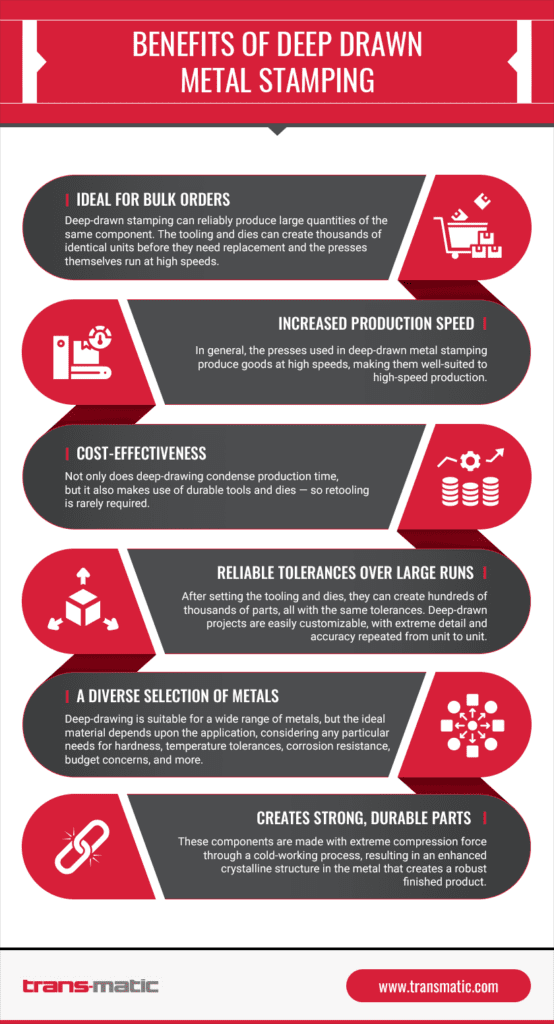CAPABILITIES
Deep Draw Metal Stamping – Trans-Matic
Deep draw stamping is a specialized metal forming process that transforms flat sheet metal into three-dimensional shapes with significant depth. It involves drawing the metal sheet into a die cavity using a punch. The process is characterized by stretching and compressing the metal to achieve the desired shape, often requiring multiple drawing operations to form the final component.
At Trans-Matic, we have honed this specialized metal forming technique since 1968, ensuring excellence in every project. Our comprehensive capabilities and industry-leading expertise make us the partner of choice for diverse companies and industries, from automotive to healthcare.
The Deep Draw Stamping Process
Material Preparation
The process begins with selecting the appropriate sheet metal material based on the specific requirements of the part to be manufactured. Factors such as material composition, thickness, and ductility are carefully considered to ensure optimal results.
Blank Cutting
Via an automated transfer process, a strip of the carefully selected material is fed into a press and blanks, which are the basis from which the part will be formed, are cut to the required size and shape.
Drawing
The blanks are moved into draw stations, where a punch applies force to draw the material into a die cavity. As the punch descends, the material is stretched and formed, gradually taking on the shape of the die cavity.
Trimming and Piercing
Once the desired shape is achieved, excess material is trimmed away from the edges of the part using trimming dies. Additional piercing operations may also be performed to create holes or openings in the component as required.
Additional Operations
Operations such as bending, flanging, or coining may be performed to further refine the shape or add features to the component. It may also undergo additional finishing processes such as cleaning, deburring, or surface treatment to enhance its appearance and performance.
Advantages of Deep Draw Stamping
Material efficiency
Cost-effectiveness
High precision
Versatility
Strength and durability
Trans-Matic’s Industry Leadership in Deep Draw Stamping
At Trans-Matic, we have established ourselves as the go-to authority in deep draw metal stamping, setting the industry standard. Here are the features and qualities that set us apart:
Advanced Machinery
Skilled Artisans
With years of experience and a dedication to excellence, our team possesses the expertise to overcome challenges and deliver superior results. From tooling design to quality control, our technicians ensure that each component meets the highest standards of craftsmanship and precision.
Diverse Product Portfolio
Trans-Matic: A Trusted Partner in Deep Draw Metal Stamping Since 1968
Trans-Matic is a leader in deep-draw metal stamping. From our humble beginnings in western Michigan, we have evolved into a trusted global supplier, offering cost-effective solutions and personalized customer service. With our state-of-the-art facility and team of highly skilled toolmakers and engineers, we can easily tackle even the most complex projects.
Contact us now to schedule a consultation and learn more about our services!
